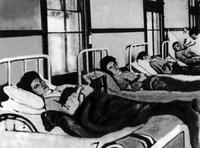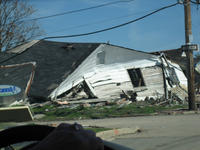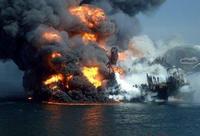-
Storm predictions for Navy, civilian planners
With the arrival of the Atlantic hurricane and Pacific typhoon season, and the often dangerous storms that can accompany it, new technology sponsored by the Office of Naval Research (ONR) will be used to help Navy and civilian officials alike plan for stormy weather, officials announced the other day.
-
-
FEMA issues annual National Preparedness Report
Presidential Policy Directive 8: National Preparedness requires an annual National Preparedness Report (NPR) that summarizes national progress in building, sustaining, and delivering the thirty-one core capabilities outlined in the National Preparedness Goal. The 2013 NPR presents an opportunity to reflect on the progress that that has been made in strengthening national preparedness and to identify where preparedness gaps remain.
-
-
Larger fire-fighting crews save lives, limit damage in high-rise fires
Between 2005 and 2009 there were, on average, 15,700 high-rise structure fires annually in the United States. Average annual losses totaled 53 civilian deaths, 546 civilian injuries, and $235 million in property damage. When responding to fires in high-rise buildings, firefighting crews of five or six members — instead of three or four — are significantly faster in putting out fires and completing search-and-rescue operations, concludes a major new study.
-
-
DHS launches Campus Resilience pilot program
DHS secretary Janet Napolitano announced Tuesday that seven universities will participate in a national preparedness initiative designed to help campuses train for, respond to, and recover from an emergency situation.
-
-
Professor to help fashion New York disaster preparedness policies
When New York governor Mario Cuomo looked over the devastation Hurricane Sandy did to Lower Manhattan and Brooklyn, he knew this should not be allowed to happen again. Cuomo also knew who to hire to make sure the city is secure. Irwin Redlener, the director and founder of the National Center for Disaster Preparedness at the Mailman School of Public Health, has been appointed as the co-chair of the New York Ready Commission, which Mayor Michael Bloomberg established after Hurricane Sandy hit the
-
-
Making buildings more tsunamis-resilient
Often in disasters such as tsunamis, people escape the on-rushing wall of water by climbing to higher ground, called vertical evacuation. As people race to the third or fourth floor of a building, however, how do they know whether the building will hold up? Walls of water often carry with them cars, trucks, and 60,000-pound fully loaded cargo containers, transforming them into projectiles which slam into buildings with tremendous force. Most structural systems are designed to defy gravity, not a side kick from a shipping container. Engineers are now studying the impact of tsunami-carried debris in order to make buildings and other structures more disaster-resilient.
-
-
U.K. revises nuke emergency plans post-Fukushima
The Sizewell nuclear power station in Suffolk, England, was decommissioned in 2006, but after the 2011 Fukushima disaster, the Suffolk authorities thought there was a need to upgrade the emergency plans for the people living around the plant. There are disagreements, however, over the radius of the emergency zone around the plant, and how many people should be included i evacuation plans and given potassium iodide tablets in the event of a radiation leak.
-
-
Why typhoid fever pathogen targets only humans

Salmonella typhiis a particularly nasty bacterium that targets only humans and causes typhoid fever, which kills hundreds of thousands of people annually; scientists explain how evolution shaped the pathogen to be so selective
-
-
Keystone XL pipeline: reliability of remote oil-spill sensors questioned
The oil industry plans to build thousands of miles of pipelines in the next five years, making leak detection a growing issue; many of the new pipelines will cross aquifers and rivers which are used for drinking water and irrigation; the Keystone XL pipeline has already experienced its share of controversies, and now there is a debate over the quality and reliability of the pipeline’s sensor system for remote detection of oil spills
-
-
At least 200,000 tons of oil, gas from Deepwater Horizon spill consumed by bacteria

Researchers have found that, over a period of five months following the disastrous 2010 Deepwater Horizon explosion and oil spill, naturally occurring bacteria which exist in the Gulf of Mexico consumed and removed at least 200,000 tons of oil and natural gas that spewed into the deep Gulf from the ruptured well head
-
-
The spring 2010 BP oil disaster could have been prevented: expert
The BP oil disaster in the Gulf of Mexico during the spring of 2010 could have been prevented if the experiences of earlier disasters had been put to use, an expert claims; the U.S. government is now accusing BP of gross negligence and deliberate misconduct, and taking the company to court
-
-
Top 5 critical hurricane preparedness actions

The National Center for Disaster Preparedness (NCDP) at Columbia University reminds Americans that hurricane preparedness lasts all season — from June to November — and that emergency preparedness is a year-round proposition, because emergencies do not have a season
-
-
Hospital-based disaster preparedness center opens in Utah
A 7,000 square-foot disaster preparedness center opened in Salt Lake City; the center is a fully-equipped environment with eighteen patient rooms, medical training mannequins, training classrooms, disaster simulation labs, and a secure supply area; the key is that the preparedness training is done in a working environment
-
-
Steps organizations should take to prepare for disasters
Even if your company has not been affected by tornados, tsunami waves, or wildfires, all employers need to be prepared for the mayhem that natural disasters cause
-
-
Scientists: Deepwater Horizon exposed gaps in deepwater oil spill knowledge

On the second anniversary of the Deepwater Horizon oil spill in the Gulf of Mexico, a national team of scientists warns that inadequate knowledge about the effects of deepwater oil well blowouts threatens scientists’ ability to help manage comparable future events
-
- All
- Regional
- Water
- Biometrics
- Borders/Immig
- Business
- Cybersecurity
- Detection
- Disasters
- Government
- Infrastructure
- International
- Public health
- Public Safety
- Communication interoperabillity
- Emergency services
- Emergency medical services
- Fire
- First response
- IEDs
- Law Enforcement
- Law Enforcement Technology
- Military technology
- Nonlethal weapons
- Nuclear weapons
- Personal protection equipment
- Police
- Notification /alert systems
- Situational awareness
- Weapons systems
- Sci-Tech
- Sector Reports
- Surveillance
- Transportation
Advertising & Marketing: advertise@newswirepubs.com
Editorial: editor@newswirepubs.com
General: info@newswirepubs.com
2010-2011 © News Wire Publications, LLC News Wire Publications, LLC
220 Old Country Road | Suite 200 | Mineola | New York | 11501
Permissions and Policies
Editorial: editor@newswirepubs.com
General: info@newswirepubs.com
2010-2011 © News Wire Publications, LLC News Wire Publications, LLC
220 Old Country Road | Suite 200 | Mineola | New York | 11501
Permissions and Policies
